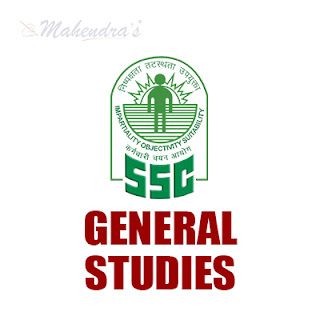
General Studies can be one of most scoring and marks gaining section in the SSC exam. This section doesn’t require any calculations and is thus the least time-consuming section, unlike other section. You can attempt this section very quickly and accurately. General Studies basically judge your basic general knowledge and how you are getting yourself updated time to time. It plays a vital role and benefits you to achieving the score required to cross the total cut off marks. Mahendra Guru providing you with an important General Studies quiz for SSC exam, it will help you to score if you regularly follow the contents of our website.
We also provide you General Studies Quiz for SSC examination based on the latest pattern.So, that you can practice on regular basis.
for all the govt exam Insurance,SSC-MTS, CGL, CHSL, State Level and other Competitive exams.
Q.1. The temperate grasslands of South America are called
(A) Downs (B) Steppes
(C) Prairies (D) Pampas
दक्षिण अमेरिका के शीतोष्ण चरागाहों (घासस्थल) को क्या कहते है?
(A) डाउन्स (B) स्टैपीज
(C) प्रेयरीज (D) पैम्पास
Q.2. Contours are the lines which are drawn joining places having.
(A) equal air pressure
(B) equal temperature
(C) equal height from mean sea level (D) equal rainfall
समोच्च रेखाएं कैसे स्थानों को मिलाते हुए खींची जाती है?
(A) सम वायु दाब वाले
(B) सम तापमान वाले
(C) माध्य समुद्र तल से सम ऊँचाई वाले
(D) सम वर्षा वाले
Q.3. Soil formed by leaching and oxidation is
(A) Red soil (B) Montane soil
(C) Black soil (D) Laterite soil
निक्षालन और आक्सीकरण द्वारा निर्मित मृदा कौन सी होती है?
(A) काली मिट्टी
(B) पहाड़ी मिट्टी
(C) काली मिट्टी
(D) मखरला (लैटेराइट) मिट्टी
Q.4. Which strait separates Australia and Tasmania?
(A) Palk
(B) Berring
(C) Bass
(D) Bab-el-Mandeb
कौन सा जलडमरूमध्य (स्टट्रे) आस्ट्रेलिया और तस्मानिया को अलग करता है?
(A) पाक
(B) बेरिंग
(C) बास
(D) बेबेल-मंडेब
Q.5. In plant-water relationships, symbol ‘’ is used to represent
(A) Solute potential
(B) Osmosis
(C) Osmotic pressure
(D) Water Potential
पादप-जल संबंधों में ‘’ प्रतीक का प्रयोग क्या दर्शाने के लिए किया जाता है?
(A) विलेय विभव
(A) विलेय विभव
(B) परासरण
(C) परासरणी दाब
(C) परासरणी दाब
(D) जल विभव
Q.6. A molecule in plants comparable to haemoglobin in animals is
(A) Chlorophyll
(B) Carotene
(C) Cytochrome
(D) Cellulose
पशुओं में हीमोग्लोबिन के सदृश पौधों में कौन सा अणु होता है?
(A) क्लोरोफिल (B) केरोटिन
(C) साइटोक्रोम (D) सेलुलोस
(A) क्लोरोफिल (B) केरोटिन
(C) साइटोक्रोम (D) सेलुलोस
Q.7. An Antigen is
(A) the stimulus for Antibody formation
(B) the residue of an Antibody
(C) the result of Antibody
(D) The opposite of Antibody
प्रतिजन क्या होता है?
(A) प्रतिरक्षी निर्माण के लिए उद्दीपन
(B) प्रतिरक्षी का अवशेष
(C) प्रतिरक्षी का परिणाम
(D) प्रतिरक्षी के विपरीत
Q.8. Blood does not coagulate inside the body due to the presence of
(A) Heparin (B) Fibrin
(C) Plasma (D) Haemoglobin
किसकी मौजूदगी के कारण शरीर के भीतर रक्त जमता नहीं है?
(A) हेपैरिन (B) फाइब्रिन
(C) प्लाज्मा (D) हीमोग्लोबिन
Q.9. Leech is an octoparasite on cattle, which is
(A) Sanguivorous (B) Herbivorous
(C) Carnivorous (D) Omnivorous
जोंक मवेशियों पर कैसा बाहृय परजीवी होता है?
(A) रक्तपिपासु (B) तृणभक्षी
(C) मांसभक्षी (D) सर्वभक्षी
Q.10. How many chambers does a mammalian heart have?
(A) 2 (B) 3
(C) 4 (D) 1
कितने कोष्ठों में स्तनी (मैमेलियन) हृदय होता है?
(A) 2 (B) 3
(C) 4 (D) 1
ANSWER KEY:-
Q.1.(B) The temperate grasslands of South America are called Pampas.
दक्षिण अमेरिका के शीतोष्ण घास स्थल को पैम्पास कहते है।
Q.2.(C) Contours are the lines equal height from Mean sea level are which drawn joining places having.
समोच्च रेखाएं माध्य समुद्र तल से सम ऊँचाई वाले स्थानों को मिलाते हुए खींची जाती है।
Q.3.(D) Soil formed by leaching and oxidation is known as laterite soil.
निक्षालन और आक्सीकरण द्वारा निर्मित मृदा लैटेराइट मिट्टी होती है।
Q.4.(C) Bass strait separates Australia and Tasmania.
बास जलडमरूमध्य आस्ट्रेलिया और तस्मानिया को अलग करता है।
Q.5.(D) In plant -water relationships, symbol Y is used to represent water potential.
पादप जल सबंधों Y प्रतीक का प्रयोग जल विभव दर्शाने के लिए किया जाता है।
Q.6.(A) A molecule in plants comparable to hemoglobin in animals is Chlorophyll.
पशुओं में हीमोग्लोबिन के सदृश पौधों में क्लोरोफिल अणु होते है।
Q.7.(D) An antigen is the opposite of antibody.
प्रतिजन प्रतिरक्षी के विपरीत होता है।
Q.8.(A) Blood does not coagulate inside the body due to the presence of heparin.
हेपैरिन की मौजूदगी के कारण शरीर के भीतर रक्त जमता नहीं है।
Q.9.(C) leech is an ectoparasite of cattle which is carnivorous.
जोंक मवेशियों पर मांसभक्षी बाह्य परजीवी होता है।
Q.10.(C) The mammalian heart have four chambers.
चार कोष्ठों में स्तनी हृदय होता है।



